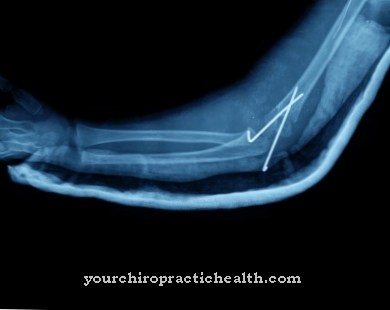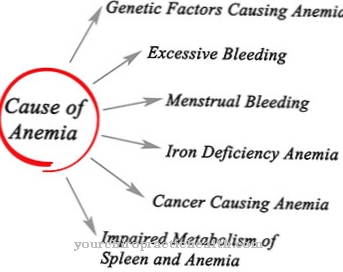The Plate fixation is a method of osteosynthesis. The fracture of a bone is treated with plates.
What is plate fixation?
A plate fixation is used when a bone fracture is surgically treated with metal plates. The plates serve to stabilize the fracture.
Plate fixation is possible in all bone areas and is suitable for all types of fractures. In most cases, the metal plates are used for fractures that directly affect the joint or for fractures near the joint. In medicine, a distinction is made between form-fitting and force-fitting plate osteosynthesis.
Function, effect & goals

A plate fixation is used when a bone fracture is surgically treated with metal plates. The plates serve to stabilize the fracture.
A plate osteosynthesis is used to treat bone fractures. The most common indications are fractures involving the joint, open fractures, bone fractures in patients with multiple trauma, as well as multiple-fragment fractures that are completely unstable.
Other areas of application for this type of osteosynthesis are broken bones in the lower limbs, fractures in which nerves or blood vessels are damaged, and complete fractures of the forearm. Which osteosynthetic treatment is ultimately carried out depends on the position and course of the bone fracture. The plate fixation is particularly suitable for the treatment of proximal upper arm fractures, a humerus shaft fracture or a proximal tibia fracture.
A plate fixation can be carried out with different plate shapes. This includes, for example, the angle plate, which is used when the distal or proximal thigh bone (femur) is broken. The support plates form a different shape. These resemble an L or T and are used to treat bone fractures that occur in the metaphyseal or epiphyseal area. There is also a reconstruction with lag screws.
Another shape is the compression plate. They are used to treat oblique fractures that are transverse and short. The compression plate is also suitable for screw osteosynthesis. By using the screw hole arrangement or with the aid of a plate tensioner, compression can be achieved in the region of the fracture gap. A fixed humerus plate is used when there is a proximal humerus fracture.
The bone fragment is clamped and held within the fixator plate with the help of special humerus head screws. The surgeon also uses standard cortex screws to anchor the stem fragment. The neutralization plate also belongs to the plate osteosynthesis forms. It has the property of neutralizing bending and torsional forces. Compression can be achieved by using lag screws.
The Less Invasive Stabilization System or LISS is a plate fixation procedure that is used to treat supracondylar fractures, intra-articular fractures and distal femoral shaft fractures. It consists of a plate-like implant and locking screws. Together they achieve the effect of an external fixator.
General anesthesia is usually given to the patient prior to performing a plate fixation. At the beginning of the procedure, the surgeon first returns the bone fragments to their normal position, which is also known as reduction. Then he treats the fracture with one of the different types of plate osteosynthesis, which depends on the type of bone fracture in question. If it is used on a lower limb, a partial load must first be carried out and then a full load must be carried out in the further course, because plate osteosynthesis is not stable.
In most cases, the plate fixation is successful and the bone fracture heals. The metallic material used is removed after 12 months at the earliest. The best time to remove the plate is 12 to 18 months. Due to the refractory risk, the removal must never be carried out earlier. On the other hand, you don't have to wait much longer than 18 months to remove the material, because the metal has then grown in so far that the screws threaten to break off.
Risks, side effects & dangers
The method of plate fixation has both advantages and disadvantages. The advantages of the surgical method include high stability and the option of early mobilization. In addition, plate osteosynthesis can counteract possible misalignments. Complicated fractures can also be treated this way.
However, there are also some negatives. Movements after surgery are often restricted due to adhesions and scarring. It is also necessary to later remove the metal plates with a second operation.
Although plate fixation is a routine medical procedure, it carries the risk of some risks and side effects. For example, the plate in the bone can loosen. Furthermore, circulatory disorders and bone infections are possible. In addition, tendons, curvatures of muscles, nerves and cartilage and stiffening of the joints are rare.
Another possible complication is the absence or insufficient healing of the bone fracture, which medical professionals call pseudarthrosis. In addition, bone necrosis can occur, in which individual parts of the bone die.
The general risks of osteosynthesis also include injuries to the nerves, the occurrence of blood clots, bleeding, local wound infections, allergic reactions to certain substances and the formation of scars. Furthermore, problems caused by the anesthesia are possible. In most cases, however, there are only very few major complications.
The patient should move again soon after the operative plate fixation. Excessive sparing of the bone is considered counterproductive and often leads to complications such as stiffening of the joints. In order to regain a normal stressful situation, physiotherapy exercises should take place regularly.




.jpg)








.jpg)











.jpg)


